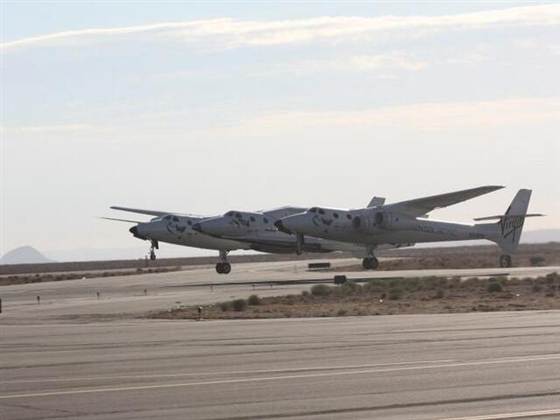Virgin Galactic’s SpaceShipTwo rocket plane, the vehicle most likely to become the world’s first truly commercial spaceship, fired its engines in flight for the second time ever on Thursday.
Following up on its first powered flight in April, the craft went supersonic once more —and tested its wing-tilting re-entry system for the first time, Virgin Galactic said in a series of Twitter updates.
The company said the flight test “hit our planned duration, altitude and speed.” The hybrid rocket engine was fired for 20 seconds, sending SpaceShipTwo to a maximum velocity 1.43 times the speed of sound and a maximum altitude of 69,000 feet (21 kilometers), Virgin Galactic reported. That compares with 16 seconds, a top speed of Mach 1.2 and a maximum altitude of 56,200 feet for April’s flight.
Pilots Mark Stucky and Clint Nichols were at the controls during Thursday’s test, which started at about 8 a.m. PT (11 a.m. ET).
The flight followed the basic scenario for Virgin Galactic’s future passenger trips to space: A twin-fuselage carrier airplane, known as WhiteKnightTwo, made a conventional takeoff from California’s Mojave Air and Space Port. SpaceShipTwo was tucked beneath WhiteKnightTwo’s 141-foot-wide (43-meter-wide) wings, and dropped into the air from an altitude of 46,000 feet.
The rocket plane’s hybrid engine was then lit up to power the plane even higher. After coasting to the top of its arc, SpaceShipTwo angled its wings into a “feathered” shuttlecock configuration to slow down its descent, then righted the wings again to glide to a Mojave runway landing at 9:25 a.m. PT (12:25 p.m. ET).
“We couldn’t be more delighted to have another major supersonic milestone under our belts as we move toward a 2014 start of commercial service,” British billionaire Richard Branson, Virgin Galactic’s founder, said in a statement issued after the landing. “It was particularly thrilling to see for the first time today the whole elegant system in action during a single flight, including the remarkable feathering re-entry system. It was this safety feature more than anything else that originally persuaded us that the overall design of the system was uniquely fit for purpose. Everything we have seen today just confirms that view.”
Full article: http://www.nbcnews.c … ed-flight-8C11080331


